Welcome to Fed’s New World of Inflation.
By Wolf Richter for WOLF STREET.
Retail sales rose by 0.6{c9ada2945935efae6c394ba146a2811ce1f3bfd992f6399f3fbbb16c76505588} in June from May, according to the Commerce Department today. But over the same period, prices for food bought at the store rose by 0.8{c9ada2945935efae6c394ba146a2811ce1f3bfd992f6399f3fbbb16c76505588}; prices at restaurants, delis, cafeterias, etc. rose by 0.7{c9ada2945935efae6c394ba146a2811ce1f3bfd992f6399f3fbbb16c76505588}; for gasoline by 2.5{c9ada2945935efae6c394ba146a2811ce1f3bfd992f6399f3fbbb16c76505588}, and for durable goods such as appliances, electronics, furniture, cars, etc., by 3.5{c9ada2945935efae6c394ba146a2811ce1f3bfd992f6399f3fbbb16c76505588} in just one month! These are the categories that make up retail sales.
And these whopping price increases in June outran the increase in retail sales in June, and they outran retail sales for the entire second quarter, indicating that consumers paid more to get less. Welcome to the Fed’s New World of inflation.
Retail sales in June rose to $621 billion (seasonally adjusted), but after the 1.7{c9ada2945935efae6c394ba146a2811ce1f3bfd992f6399f3fbbb16c76505588} drop in May, remain below March and April:
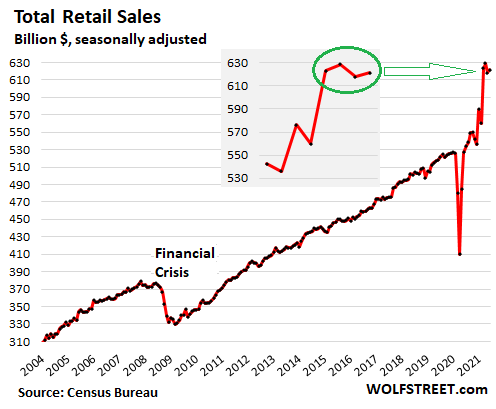
New & used auto dealers and parts stores: Sales fell 2.0{c9ada2945935efae6c394ba146a2811ce1f3bfd992f6399f3fbbb16c76505588} in June, to $132 billion (seasonally adjusted), the second month in a row of declines from the historic WTF spike in March and April. Sales fell despite colossal price increases:
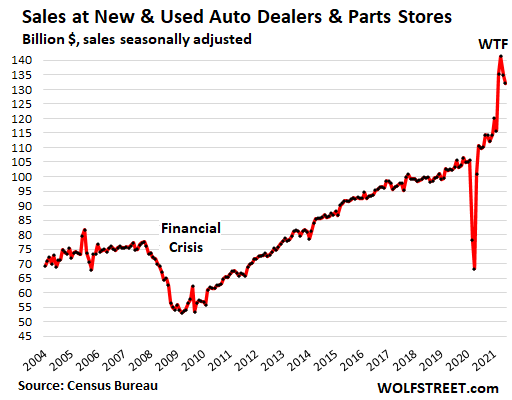
These colossal price increases showed up in the CPI for used vehicles which spiked by a previously unimaginable 10.5{c9ada2945935efae6c394ba146a2811ce1f3bfd992f6399f3fbbb16c76505588} in June and by an equally unimaginable 45{c9ada2945935efae6c394ba146a2811ce1f3bfd992f6399f3fbbb16c76505588} year-over-year; and in the CPI for new vehicles that jumped by 1.8{c9ada2945935efae6c394ba146a2811ce1f3bfd992f6399f3fbbb16c76505588} in June, as people bought far fewer vehicles but paid out of their nose for them.
People who are trying to buy under these conditions are begging to get screwed. Just say no. Most people can delay by a year or more the purchase of a vehicle because they can just keep driving what they have, which is what they did during the Financial Crisis, when auto sales collapsed for a couple of years as people went on buyers’ strike. We can now see the first few qualms building up at buying cars and trucks at these crazy prices.
In terms of the number of vehicles, used vehicle retail sales fell by 2.7{c9ada2945935efae6c394ba146a2811ce1f3bfd992f6399f3fbbb16c76505588} in June from May (seasonally adjusted) and were down 7.8{c9ada2945935efae6c394ba146a2811ce1f3bfd992f6399f3fbbb16c76505588} year-over-year. And sales of new cars and trucks plunged by 14{c9ada2945935efae6c394ba146a2811ce1f3bfd992f6399f3fbbb16c76505588} in June from May (seasonally adjusted):
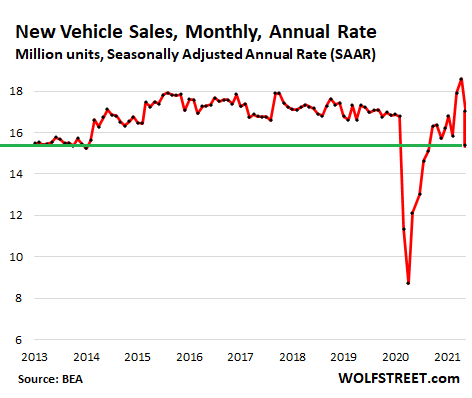
The retailer segments by magnitude.
Auto dealers and parts stores are by far the largest segment in dollar-sales terms, accounting for about 21{c9ada2945935efae6c394ba146a2811ce1f3bfd992f6399f3fbbb16c76505588} of total retail sales (black line). Nonstore retailers, which is mostly ecommerce, have jumped to second place during the pandemic (top red line). Grocery and beverage stores are in third place (green line), followed by bars, restaurants, and other “food services and drinking places” (purple line), followed by general merchandise stores (such as Walmart), and building material and garden supply stores (such as Home Depot), followed by the rest:
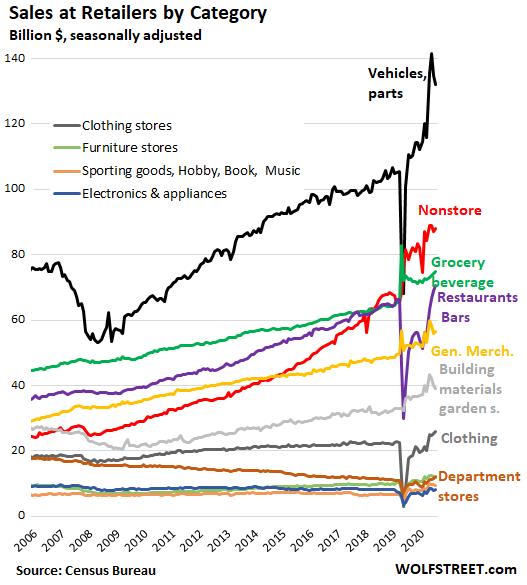
Ecommerce and other “non-store retailers”: Sales rose 1.2{c9ada2945935efae6c394ba146a2811ce1f3bfd992f6399f3fbbb16c76505588} in June from May, to $88 billion, seasonally adjusted. Compared to June 2019, sales jumped by 31{c9ada2945935efae6c394ba146a2811ce1f3bfd992f6399f3fbbb16c76505588}. This includes ecommerce sales by pure online retailers and by the online operations of brick-and-mortar retailers, sales by mail-order, at street stalls, vending machines, etc.
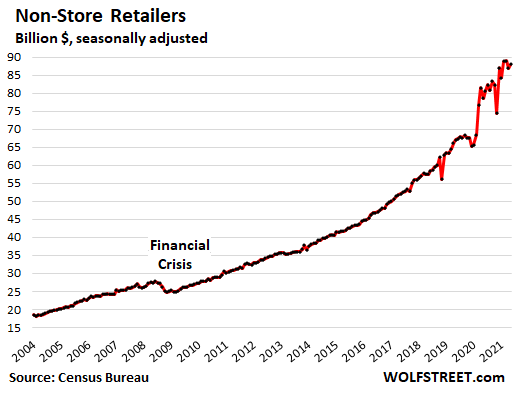
Food and Beverage Stores: Sales ticked up 0.6{c9ada2945935efae6c394ba146a2811ce1f3bfd992f6399f3fbbb16c76505588} in June to $75 billion, as the CPI for food bought at stores rose 0.8{c9ada2945935efae6c394ba146a2811ce1f3bfd992f6399f3fbbb16c76505588} – paying more to get less.
Working from home, not working at all, and starting small businesses out of the house have shifted some consumption from commercial buildings to households, and thereby to supermarkets.
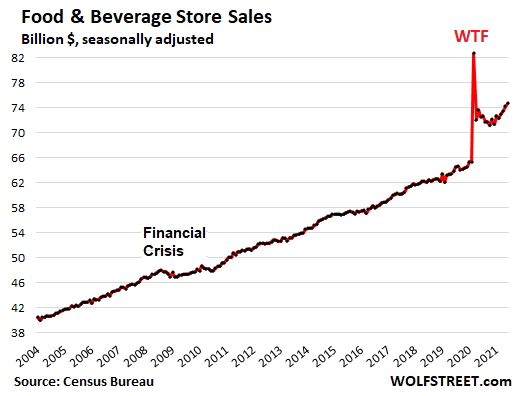
Restaurants & Bars: Sales rose 2.3{c9ada2945935efae6c394ba146a2811ce1f3bfd992f6399f3fbbb16c76505588} in June to a new record of $71 billion, amid widespread price increases.
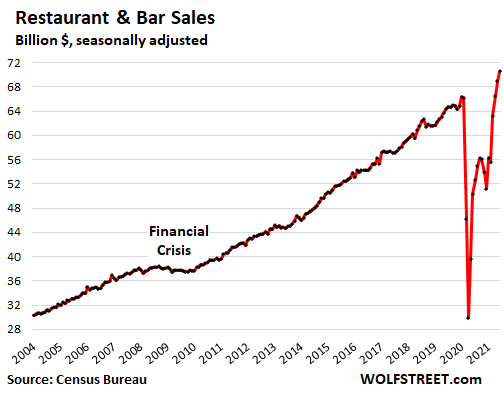
General merchandise stores: Sales ticked up 1.1{c9ada2945935efae6c394ba146a2811ce1f3bfd992f6399f3fbbb16c76505588} in June, to $56 billion, after two months of declines, and were up 17{c9ada2945935efae6c394ba146a2811ce1f3bfd992f6399f3fbbb16c76505588} from June 2019. This segment includes the brick-and-mortar stores of Walmart, Costco, and Target; but not their ecommerce sales, which are included in “nonstore retailers”:
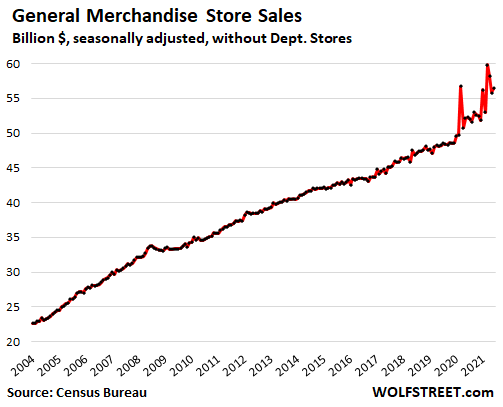
Building materials, garden supply and equipment stores: Sales fell 1.6{c9ada2945935efae6c394ba146a2811ce1f3bfd992f6399f3fbbb16c76505588} in June, the third month in a row of declines, to $39 billion, but were still up 25{c9ada2945935efae6c394ba146a2811ce1f3bfd992f6399f3fbbb16c76505588} from June 2019:
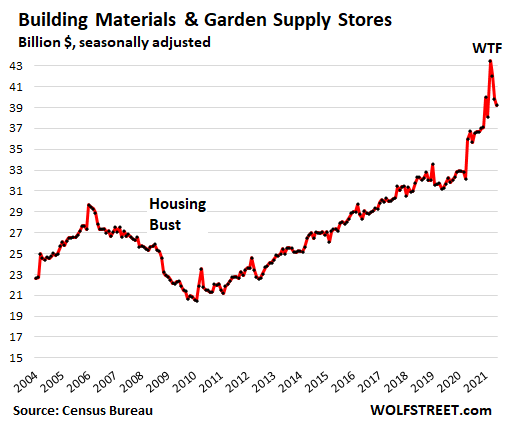
Gas stations: Sales rose 2.5{c9ada2945935efae6c394ba146a2811ce1f3bfd992f6399f3fbbb16c76505588} in June, to $47 billion, as the average price of gasoline also rose 2.5{c9ada2945935efae6c394ba146a2811ce1f3bfd992f6399f3fbbb16c76505588} in June, indicating that consumers bought about the same quantity of gasoline, but paid more for it. Gasoline prices are now at levels not seen since October 2014, when the Oil Bust began, and sales at gasoline stations followed. Sales at gas stations include all the other stuff they sell, from sodas to motor oil:
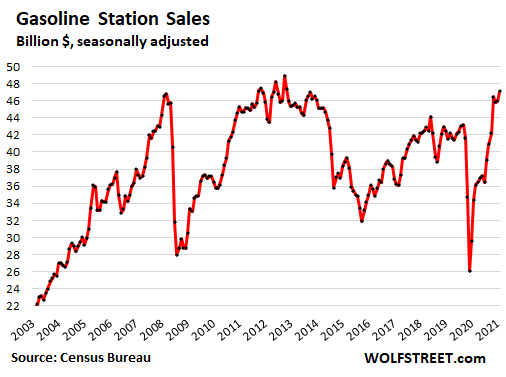
Clothing and accessory stores: Sales rose 2.6{c9ada2945935efae6c394ba146a2811ce1f3bfd992f6399f3fbbb16c76505588} in June, to $26 billion, up 16{c9ada2945935efae6c394ba146a2811ce1f3bfd992f6399f3fbbb16c76505588} from April 2019:
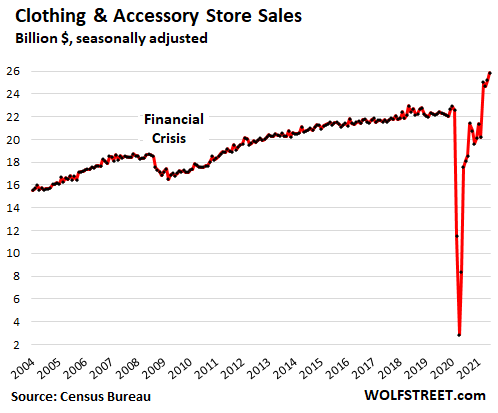
Furniture and home furnishing stores: Sales fell 3.6{c9ada2945935efae6c394ba146a2811ce1f3bfd992f6399f3fbbb16c76505588} for the month, to $12 billion, but were up 19{c9ada2945935efae6c394ba146a2811ce1f3bfd992f6399f3fbbb16c76505588} from May 2019. The CPI for furniture and bedding jumped by 2.1{c9ada2945935efae6c394ba146a2811ce1f3bfd992f6399f3fbbb16c76505588} in April, another 1.9{c9ada2945935efae6c394ba146a2811ce1f3bfd992f6399f3fbbb16c76505588} in May, and another 0.7{c9ada2945935efae6c394ba146a2811ce1f3bfd992f6399f3fbbb16c76505588} in June for a combined three-month inflation of 4.7{c9ada2945935efae6c394ba146a2811ce1f3bfd992f6399f3fbbb16c76505588}. Over the same three-month period, sales dropped by 4.8{c9ada2945935efae6c394ba146a2811ce1f3bfd992f6399f3fbbb16c76505588}. In other words, consumers paid less to get a lot less:
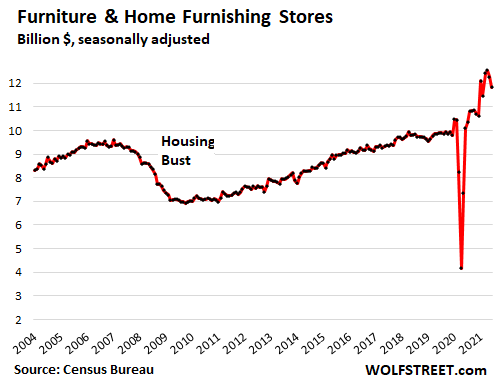
Department stores: sales rose 5.9{c9ada2945935efae6c394ba146a2811ce1f3bfd992f6399f3fbbb16c76505588} for the month to $12 billion, and were up 7.1{c9ada2945935efae6c394ba146a2811ce1f3bfd992f6399f3fbbb16c76505588} from June 2019. This includes sales at brick-and-mortar stores of Macy’s, Kohl’s, J.C. Penney, etc., but not their ecommerce sales:
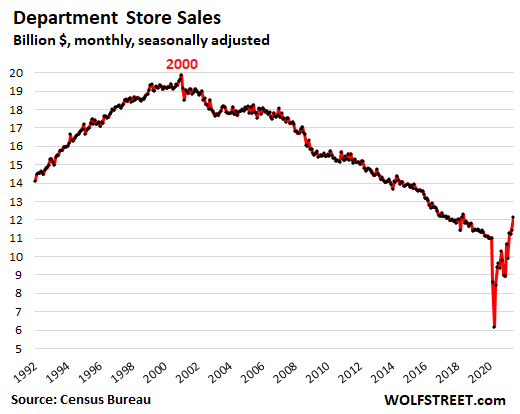
Sporting goods, hobby, book and music stores: Sales ticked down 1.7{c9ada2945935efae6c394ba146a2811ce1f3bfd992f6399f3fbbb16c76505588} for the month, to $9.4 billion, the third month in a row of declines, after the spike in March. Compared to June 2019, sales are up 38{c9ada2945935efae6c394ba146a2811ce1f3bfd992f6399f3fbbb16c76505588}:
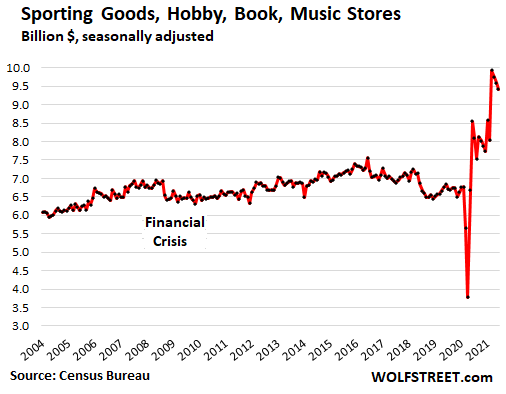
Electronics and appliance stores: Sales rose 3.3{c9ada2945935efae6c394ba146a2811ce1f3bfd992f6399f3fbbb16c76505588} for the month, and were up 2.1{c9ada2945935efae6c394ba146a2811ce1f3bfd992f6399f3fbbb16c76505588} from June 2019. Most consumers buy electronics and appliances online, a booming business, and sales at these brick-and-mortar stores have been declining for years, to where they’re now below where they’d been in 2005:
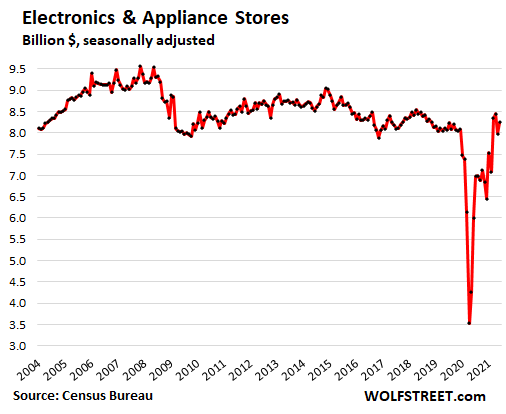
Enjoy reading WOLF STREET and want to support it? Using ad blockers – I totally get why – but want to support the site? You can donate. I appreciate it immensely. Click on the beer and iced-tea mug to find out how:

Would you like to be notified via email when WOLF STREET publishes a new article? Sign up here.
![]()



More Stories
Car Stereo System and Its Installation
Black and Silver Nokia 6303 – Two Classic Models From the Nokia Camp
Motorcycle Clubs 101 – How to Create Motorcycle Club Bylaws Part I